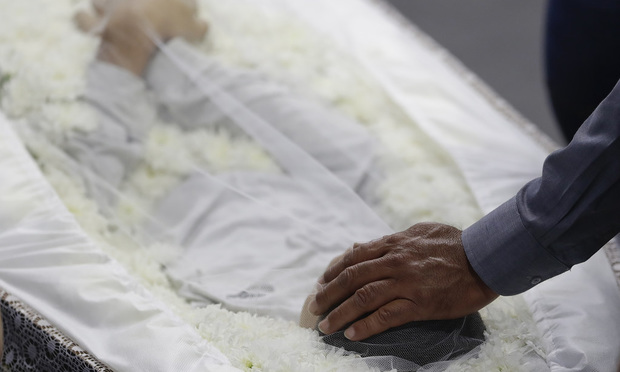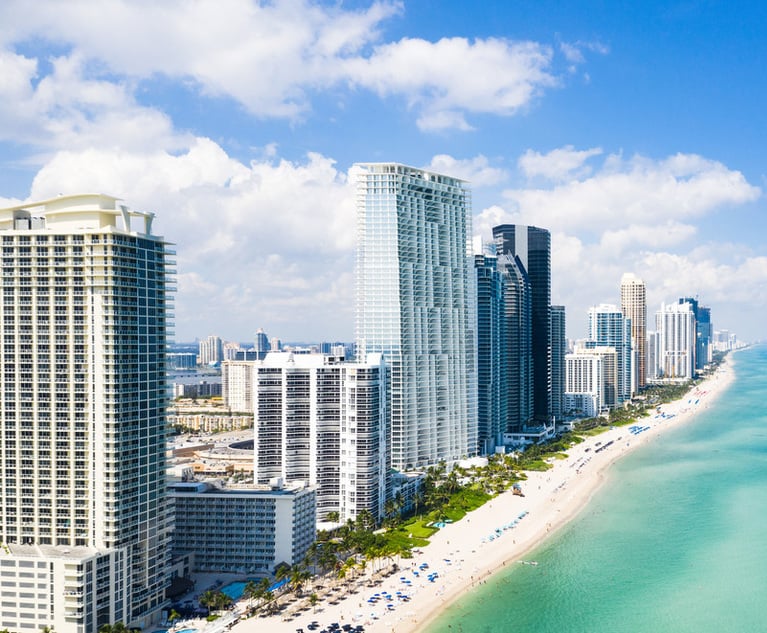Brazil Police: School Attackers Imitating Columbine Massacre
Friends and former classmates told investigators that 17-year-old Guilherme Taucci Monteiro and 25-year-old Henrique de Castro were obsessed with the attack on Columbine High School.
March 15, 2019 at 10:59 AM
6 minute read
 A relative places his hand on the head of school shooting victim Caio Oliveira during a collective wake for those who died in Suzano, greater Sao Paulo area, Brazil, March 14. (AP Photo/Andre Penner)
A relative places his hand on the head of school shooting victim Caio Oliveira during a collective wake for those who died in Suzano, greater Sao Paulo area, Brazil, March 14. (AP Photo/Andre Penner)
Two young men who stormed their former school in southern Brazil armed with a gun, crossbows and axes, killing seven people, were trying to emulate the 1999 Columbine attack in Colorado and had been planning the assault for months, police said.
Friends and former classmates told investigators that 17-year-old Guilherme Taucci Monteiro and 25-year-old Henrique de Castro were obsessed with the attack on Columbine High School, Sao Paulo civil police director Ruy Ferraz told a news conference. He said the pair had been planning the attack since at least November.
Ferraz said the acquaintances said they didn't believe the attack would actually happen, or feared that telling anyone would make them targets.
The Colombine attack, also undertaken by two heavily armed young men, left 13 dead. And as in Wednesday's rampage, the Columbine assailants took their own lives.
Monteiro and de Castro “wanted to prove they could act like in Columbine High School with cruelty and with a tragic character so they could be more recognized than” even the Columbine killers, Ferraz said.
Ferraz said a third person, a 17-year-old former student at the school, had been involved in planning but was not present at the school when the attack happened.
He did not identify the accomplice but said police have asked a judge to issue a warrant for the teen's arrest.
The developments came hours after classmates, friends and relatives of the victims began saying goodbye during a mass wake in the Sao Paulo suburb of Suzano, where the attack happened.
Before launching the school assault, police said the assailants shot and killed Monteiro's uncle, who owned a used-car dealership nearby. Monteiro had worked at the dealership, but had been fired by his uncle for petty crimes.
What happened next at the K-12 school, partially caught on surveillance camera footage at the building's entrance and widely distributed in Brazil, was stomach-churning.
It showed Monteiro entering and shooting several people in the head as they tried to run away. De Castro followed, first striking wounded people with an ax and then swinging it wildly while scores of students ran past him. De Castro then armed his crossbow and walked farther into the school.
The dead included five students, a teacher and a school administrator. Nine others were wounded in the attack, including seven still hospitalized Thursday.
“I couldn't sleep. I have two children in school and they are about the age of the victims,” said Wanda Augusta, a 46-year-old homemaker attending the wake.
“If only we could have identified the difficulties of these boys” before the attack, said Rossieli Soares, the state education secretary, who attended the wake at a volleyball arena. “This is a problem in our society.”
Police seized computers and notebooks from the homes of the two attackers, who were neighbors and lived less than a mile from the school. They also took computers from an arcade near the school that the attackers frequented.
While Latin America's largest nation has deep problems with violence — it's the world leader in annual homicides — school shootings like those in the U.S. are rare. Wednesday's attack reminded many Brazilians of an attack in 2011, when a gunman roamed the halls of a Rio de Janeiro school and killed 12 students.
Joao Camilo Pires de Campos, Sao Paulo state's public security secretary, summed up what was on the minds of many Brazilians.
“The big question is: What was the motivation of these former students?” he told reporters Wednesday.
Monteiro's mother, Tatiana Taucci, offered a possible partial answer, saying that her son had been bullied at the school.
“Bullying, they call it. … He stopped going to school … because of this,” she told the Band News TV network.
Still, she said she was as surprised as anyone by her son's involvement in the attack, which she said she heard about on television like everyone else.
Ferraz, the police director, said that while bullying had been mentioned in some testimony from acquaintances, they did not believe it to be meaningful to the investigation.
Minutes before the school rampage, Monteiro posted 26 photos on his Facebook page, including several with a gun and one that showed him giving the middle finger as he looked into the camera.
In some of the photos, he wore a black scarf with a white imprint of a skull and cross bones. No text accompanied the posts.
During the attack, Monteiro opened fire with a .38 caliber handgun and de Castro used a crossbow, de Campos said.
The attackers were also carrying Molotov cocktails, knives and small axes, authorities said.
One of the wounded, Jose Vitor, ran to a hospital close to the school with an ax still lodged in his right shoulder.
“He is an agile adolescent,” his mother, Sandra Regina Ramos, told reporters outside the hospital. “He reacted quickly.”
The assailants were trying to force their way inside a room at the back of the school where many students were hiding when police arrived. Instead of facing the officers, Monteiro shot de Castro in the head and then shot himself, authorities said.
Katia Sastre, a police officer who was elected to Congress after a video showed her gunning down an armed robber outside her daughter's school went viral last year, called on authorities to provide better security at schools.
“This could have been prevented if upstanding citizens were able to defend themselves and bear arms,” said Sastre, who is a former student at the school attacked Wednesday.
The debate over whether to expand access to guns, a priority of President Jair Bolsonaro's administration, was present in many of the public statements by politicians. Soon after his Jan. 1 inauguration, Bolsonaro issued a decree making it easier to buy a gun. His party plans to put forward legislation that would go even further, loosening restrictions on carrying and the number and types of firearms Brazilians can own.
Mauricio Savarese and Peter Prengaman report for the Associated Press. Anna Jean Kaiser contributed reporting from Rio de Janeiro.
This content has been archived. It is available through our partners, LexisNexis® and Bloomberg Law.
To view this content, please continue to their sites.
Not a Lexis Subscriber?
Subscribe Now
Not a Bloomberg Law Subscriber?
Subscribe Now
NOT FOR REPRINT
© 2025 ALM Global, LLC, All Rights Reserved. Request academic re-use from www.copyright.com. All other uses, submit a request to [email protected]. For more information visit Asset & Logo Licensing.
You Might Like
View All
Winston & Strawn Snags Sidley Austin Cross-Border Transactions Partner in Miami
2 minute read
Miami’s Arbitration Week Aims To Cement City’s Status as Dispute Destination
3 minute read
Brazil Is Quickly Becoming a Vital LatAm Market for Greenberg Traurig, Other US Law Firms
5 minute readTrending Stories
- 1Paul Hastings, Recruiting From Davis Polk, Continues Finance Practice Build
- 2Chancery: Common Stock Worthless in 'Jacobson v. Akademos' and Transaction Was Entirely Fair
- 3'We Neither Like Nor Dislike the Fifth Circuit'
- 4Local Boutique Expands Significantly, Hiring Litigator Who Won $63M Verdict Against City of Miami Commissioner
- 5Senior Associates' Billing Rates See The Biggest Jump
Who Got The Work
J. Brugh Lower of Gibbons has entered an appearance for industrial equipment supplier Devco Corporation in a pending trademark infringement lawsuit. The suit, accusing the defendant of selling knock-off Graco products, was filed Dec. 18 in New Jersey District Court by Rivkin Radler on behalf of Graco Inc. and Graco Minnesota. The case, assigned to U.S. District Judge Zahid N. Quraishi, is 3:24-cv-11294, Graco Inc. et al v. Devco Corporation.
Who Got The Work
Rebecca Maller-Stein and Kent A. Yalowitz of Arnold & Porter Kaye Scholer have entered their appearances for Hanaco Venture Capital and its executives, Lior Prosor and David Frankel, in a pending securities lawsuit. The action, filed on Dec. 24 in New York Southern District Court by Zell, Aron & Co. on behalf of Goldeneye Advisors, accuses the defendants of negligently and fraudulently managing the plaintiff's $1 million investment. The case, assigned to U.S. District Judge Vernon S. Broderick, is 1:24-cv-09918, Goldeneye Advisors, LLC v. Hanaco Venture Capital, Ltd. et al.
Who Got The Work
Attorneys from A&O Shearman has stepped in as defense counsel for Toronto-Dominion Bank and other defendants in a pending securities class action. The suit, filed Dec. 11 in New York Southern District Court by Bleichmar Fonti & Auld, accuses the defendants of concealing the bank's 'pervasive' deficiencies in regards to its compliance with the Bank Secrecy Act and the quality of its anti-money laundering controls. The case, assigned to U.S. District Judge Arun Subramanian, is 1:24-cv-09445, Gonzalez v. The Toronto-Dominion Bank et al.
Who Got The Work
Crown Castle International, a Pennsylvania company providing shared communications infrastructure, has turned to Luke D. Wolf of Gordon Rees Scully Mansukhani to fend off a pending breach-of-contract lawsuit. The court action, filed Nov. 25 in Michigan Eastern District Court by Hooper Hathaway PC on behalf of The Town Residences LLC, accuses Crown Castle of failing to transfer approximately $30,000 in utility payments from T-Mobile in breach of a roof-top lease and assignment agreement. The case, assigned to U.S. District Judge Susan K. Declercq, is 2:24-cv-13131, The Town Residences LLC v. T-Mobile US, Inc. et al.
Who Got The Work
Wilfred P. Coronato and Daniel M. Schwartz of McCarter & English have stepped in as defense counsel to Electrolux Home Products Inc. in a pending product liability lawsuit. The court action, filed Nov. 26 in New York Eastern District Court by Poulos Lopiccolo PC and Nagel Rice LLP on behalf of David Stern, alleges that the defendant's refrigerators’ drawers and shelving repeatedly break and fall apart within months after purchase. The case, assigned to U.S. District Judge Joan M. Azrack, is 2:24-cv-08204, Stern v. Electrolux Home Products, Inc.
Featured Firms
Law Offices of Gary Martin Hays & Associates, P.C.
(470) 294-1674
Law Offices of Mark E. Salomone
(857) 444-6468
Smith & Hassler
(713) 739-1250







